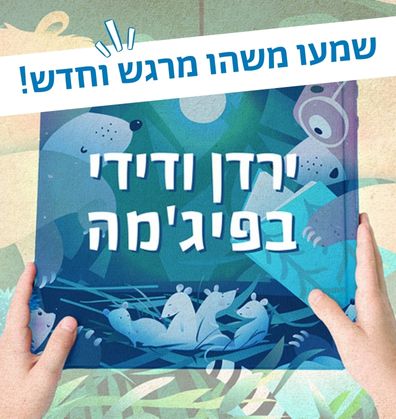כִּשּׁוּרֵי חַיִּים
נדיבות
ילדות וילדים שונים זה מזאת ביכולת לשתף, לחלוק ולהעניק. סיפורים על נדיבות מנקודות מבט שונות, יכולים להציג כיצד היא באה לידי ביטוי במגוון אופנים, בין דמויות שונות ובמצבים משתנים, ומאפשרים לבחון יחד - מהי נדיבות? איך אנחנו מרגישים כשאנחנו נדיבים כלפי אחרים, ואיך אנחנו מרגישים כשנדיבים כלפינו?
סְּפָרִים
Book-Related Family Activities

Family reading advice
Books containing very few words allow us to tell an emotional and experiential story as we follow the main character in the book: What is he feeling? What is he thinking about? When is he sad and when does he get a new idea? You can look at the illustrations, get to know the main character and his experiences, link them to your own lives and, most of all, add something of yours to this experience that is being described in so few words and in heartwarming illustrations.

A gift of something
Did Mooch only give Earl an empty box for a gift? You can discuss gifts that cannot be put into boxes: Which free gifts can you give one another? A hug? A drawing? How about warm loving words?

A box of nothing
You can also have your own box of nothing. Take a box or paper bag, decorate it with paper, drawings, stickers and decorations. Whenever you are bored, open the box and use your imagination to decide what is in it: Maybe it contains an imaginary ball that you can pretend to toss between you, or an imaginary story that you have made up together, or any other invention with which you can come up.

Our books
Have you tried reading a book using a bird’s voice? Perhaps you happen to own a red book? Scan the code and you can play a game that encourages reading using the books you have at home. You can even get a certificate at the end of it!

Doing nothing
What happens when we do nothing? You should take a few minutes to sit quietly and listen. What can you hear? What can you see? What can you feel with your body? You can share your experience with your family and think together: Does nothing really happen when we do nothing?
Proposed Family Activities:
- You may want to snuggle up and leaf through the illustrations together. You could ask your child to show you what Toto and La La are doing on each page. What kind of expression does Toto have on his face when La La refuses to share her bucket and spade with him? When are both friends smiling?
- Perhaps you could take some stuffed animals or puppets and act the story out together.
- At the end of the book, Toto and La La “party”. You may want to think of things that make you want to party, and how you enjoy partying with friends.
- Perhaps you would like to discuss the difference between personal items and those that belong to your entire family with your child. You could walk through the various rooms in your house, and identify those items that are “only mine”, such as a toothbrush, versus those who belong to the entire family, like the living room couch.
- Does your child enjoy playing with sand? You could do so at the beach, or even in your own garden or backyard. Use items found in every home along with your bucket and space: plastic boxes, sieves and strainers, spoons, funnels, etc.
- When friends come over, it is sometimes hard to share our toys with them. Perhaps you could decide in advance which toys to offer them, and which to keep aside. You may want to encourage your child to be kind to their friends when they come and visit, and share their games with them. You can later discuss the warm feeling you get when you make friends happy by sharing with them.
Proposed Family Activities:
- You may want to snuggle up and look through the book together. You could follow Tani’s facial expressions and ask your child: How, do you think, Tani felt when his sister chose to give Mama a flower?
- We suggest pausing at the page on which Tani announces that he, too, needs a box for his gift, and asking your child: what will Tani’s gift for his mother be, do you think? What gift would you like your child to prepare for you?
- You could act the story out using puppets. Together, you can imagine what the puppets will do with their mother at the end of the play.
- Perhaps you could play a game called “what’s the gift?”. Each player in turn picks a toy or small object and puts it in a box. The other players try to guess what is in the box by asking questions and receiving clues. For example: Is the gift an animal? Is it something yummy? Is it made of wood?
Were you able to guess which gifts were hiding in the boxes?
- You may want to tell your child how you honored or are currently honoring your own parents, and remind one another of the ways in which your child honors you. Together you can think of an older family member you could honor – perhaps by giving them a flower or hug, or surprising them with a phone call.
- How about choosing a box and decorating it with stickers, drawings, and ribbons? Perhaps you could decide together to whom you will now give it.
You may want to snuggle up on the couch together
You may want to snuggle up on the couch together, give your child a kiss, and ask them when they like to be kissed, whether they like to be woken up with a kiss, and who they like kissing.
While reading the story
While reading the story, we suggest pausing before the kiss sprouts, and asking your child whether or not they think the kiss will indeed grow. You could let them leaf through the book, and try to discover the rest of the story for themselves.
Little Miss plants
Little Miss plants, waters, and cares for her kiss. Your child can also help you plant some flowers or grow a vegetable patch. You could also sprout beans or chickpeas, and observe the magic of growth.
You may enjoy going on a kissing spree around the house
You may enjoy going on a kissing spree around the house, giving all family members kisses, calling your grandparents, uncles, and aunts and blowing them kisses over the telephone, and feeling how pleased kisses make your entire family, and how much joy they bring.
You may want to put on some lipstick, and fill a blank sheet of paper with colorful kisses
You may want to put on some lipstick, and fill a blank sheet of paper with colorful kisses. Once your sheet of paper is full, you can cut out the kisses, and use them to decorate your child’s bedroom.
6. How about baking kisses
How about baking kisses (Hebrew for baked meringues) and giving them out to your loved ones?
Ingredients
8 egg whites
1 ¼ cups of sugar
1 teaspoon of fresh lemon juice
Method
Heat your oven to 130 degrees.
Whisk the egg whites with the sugar and lemon juice until the mixture is stiff and glossy.
Line a baking pan with parchment paper, put the mixture into a pastry bag, and pipe meringues onto the pan.
Bake for approximately two hours.
Give away your meringues (kisses) to all your friends, neighbors and family!
Enjoy reading and doing the activities together!
Proposed Family Activities:
- You may want to leaf through the book together, and look for all the animals: the hedgehog, rabbit, squirrel, and mouse. Have you discovered any other animals hiding in the woods?
- It may be advisable to read the story several times to allow your child to remember the sequence of events, and join you as you read the recurring lines: “רעבים ביער לא חסר, כדאי מאוד להסתתר” [“Many in the woods are hungry, it is best to hide”], and “התפוח גדול, אפשר גם לכבד” [“It’s a big apple, we can share it”].
- You may enjoy discussing moments in which we share with or give to others together. Remind your child how we host friends, share toys in kindergarten, or offer others some of our yummy snack.
- Each animal has a unique way of walking: the hedgehog takes small steps, the rabbit hops, the squirrel skips, and the mouse pitter patters. You could play charades together, imitating the various characters in the book: one of you does the imitation, while the other guesses which of the characters they are pretending to be.
- You may enjoy acting the story out using stuffed animals you have at home. You could also make animal costumes using old fabrics: cut various shaped ears, attach them to hair bands, and become hedgehogs, rabbits, squirrels, and mice.
- The friends in the book enjoy a meal together in which each of them gives and gets from the others. You may enjoy organizing a picnic with some friends or neighbors, in which each of you brings something from home, and shares it with the others.
- You could make a pinecone hedgehog with your child, and ask them to paint it with some paints and a paintbrush. Who will be the happy recipient of this colorful gift?
האזינו לסיפור "העופר המסכן" מהספר "סיפורי חיות"
הקשיבו, הקשיבו!!! 🎧 ילדות וילדים, הורים וצוותים חינוכיים ❤️ הימים האלו עכשיו הם ימים לא רגילים, ובימים כאלה סיפורים יכולים לשמח, לרגש, אפילו להצחיק. אנו מזמינים אתכם/ן להאזין להקלטה הקסומה של הסיפור “העופר המסכן”, מתוך “סיפורי חיות”, מאת: עודד בורלא | איורים: אסיה אייזנשטיין | הוצאת: ידיעות ספרים.
יוצרים ומגישים – ירדן בר כוכבא – הלפרין ודידי שחר מוזיקה ונגינה – טל בלכרוביץ’ פתיח ההסכת ולחן השיר בסיפור “החוצה” – דידי שחר.
מוכנים/ות? מת – חי – לים! ▶️
האזינו לסיפור "ההמצאות של קרפד"
הקשיבו, הקשיבו!!! 🎧 ילדות וילדים, הורים וצוותים חינוכיים ❤️ הימים האלו עכשיו הם ימים לא רגילים, ובימים כאלה סיפורים יכולים לשמח, לרגש, אפילו להצחיק. אנו מזמינים אתכם/ן להאזין להקלטה הקסומה של הסיפור “ההמצאות של קרפד” מתוך הספר “סיפורי חיות” מאת: עודד בורלא, איורים: אסיה אייזנשטיין.
יוצרים ומגישים: ירדן בר כוכבא – הלפרין ודידי שחר
מוזיקה ונגינה: טל בלכרוביץ’
פתיח: דידי שחר

Oded Burla (1915–2009)
Author, poet and painter Oded Burla was born in Jerusalem Sephardi family that had lived in this country for over thirteen generations. He published his first book at the age of 45, and went on to write and illustrate more than 70 children’s books, in which, he once claimed, 346 different animals were mentioned! Burla is considered the founding father of nonsense in Hebrew children’s literature; his books are filled with sophisticated humor and a use of language that is both surprising and amusing. For his work, Oded Burla has been awarded the Zeev Prize, ACUM Award, and Bialik Prize.

Proposed Family Activities:
- Animal stories have morals from which people can learn. You may enjoy reading the stories together, and trying to discover the subtle messages conveyed by them. What makes someone pitiful? Why did the tiger help the warbler? Is kindness contagious? And what can a squirrel teach us about independence?
- What about the stories did your child find amusing? The animals and their behavior? The surprising endings the author chose for his stories? Or perhaps the illustrations?
- The toad is an inventor with a great imagination. But are all his inventions necessary or useful? Perhaps you could also let your imaginations run wild, and invent new things together. Are your inventions useful?
- In the poem entitled “Noah’s chick” (HaEfroah shel Noach), almost every line rhymes with “Noah”. You may also choose a word or sound, and try to write a poem in which every line rhymes with that sound. How long was your poem?
- The story about Sakiki the Saki contains a plethora of idioms and phrases containing the Hebrew word for “eye” – ayin. You may want to make an amusing, illustrated dictionary together containing all the expressions found in this story in picture form.
- Do you also like animals and stories? Then how about going to the zoo with a notebook and pen, and drawing all the animals that remind you of certain people? Together, you can make up stories with morals about them, and write them down, to create your very own animal stories.
Family reading tips
Adrianus (Hadrian) was a Roman emperor from 117 to 138. The Roman empire thrived under his reign. Adrianus suppressed the Bar Kokhba revolt and enacted regulations against the Jewish people. In the Talmudic legends (Midrashim) he is described as a wise and well-educated emperor, but also as being cruel. He is often cited as the main cause of the destruction of Judea.
Basket full of gifts
Special gifts are passed through generations: a family story, a tasty recipe or a unique holiday tradition. What important gift did you receive from your parents, grandparents or other family members?

Past to future
Take a look around the house: What items can you find that were made in the past? Can you find things that were created recently which can be used by future generations? Maybe a new building being built, a playground, a school or a grove?

Make a family album
The old man in the story left figs for future generations, and we are left with the story. Why not create a family album with family photos and stories. You can add photos from trips or special occasions, and share stories of things you experienced.

Find more arts and craft projects, songs and other activities on Sifriyat Sifriyat Pijama Library’s Pinterest page.
"I will save the soup!"
“I will save the soup!” You may want to read the story together, pause each time the giant is about to say “I will save the soup!”, and ask your child to shout out the phrase. You may also enjoy looking at the illustrations together, and discover details that do not appear in the text. What do you see in the giant’s kitchen? Have you noticed the bird? You could imagine together what the rest of the rooms in the giant’s big house might be like.
Acting the story out
Acting the story out: You could act out the story using cooking utensils. Take out pots of different sizes, a spoon and ladle, and prepare imaginary soup. Your child can act the story out, telling it in their own words. You could continue past the end of the text, and imagine what happened once the guests had left the giant with a pile of dirty dishes and more ingredients for a soup.
Sweet or savory?
Sweet or savory? You may want to experiment with flavors together. Take two identical plates, pour some sugar into one, and salt into the other. Ask your child to taste from each plate, and guess whether it is sweet or salty. Could they figure it out? You could later discuss your family’s preferences, and prepare a family dinner consisting of one savory dish, a sweet dessert, something spicy, and something sour.
Fixing is possible
Fixing is possible: What is hard to fix or needs fixing in your house? Together you could try to find solutions. Is your room crowded, and filled with items you find little use for? You could ask your child to choose some toys they no longer play with, and give them to a child younger than them. Is one of their games broken? Perhaps it can be glued together again. Are they bored and looking for a new book to read? You could get a group of friends together, and have them swap books among them. You could consult your child about identifying the difficulties, and commend them for finding creative solutions to them.
Soup stories
Soup stories: Do you know any other stories about soup? You may want to look for books such as Nira Harel’s Grandpa Cooked a Soup, or Aubrey Davis’ Bone Button Borscht at home or the public library, and read them together. Both these books were given as part of PJ Library in previous years.
A soup fest
A soup fest: You could also make soup together. Who would you invite to eat it with you?
Ingredients:
2 large onions, chopped
3–4 cloves of garlic, crushed
4 carrots, diced
3 zucchinis, diced
3 potatoes, diced
2 cups of pumpkin, diced
A packet of celery
Some parsley or coriander
Salt, pepper, turmeric
Method:
Fry the onions and garlic in some oil until golden.
Add the vegetables, chopped herbs and spices, and stir.
Keep stirring until all the vegetables have been fried and somewhat softened.
Add boiling water, and cook until all vegetables have thoroughly softened.
Taste, adjust seasoning if necessary, and serve.
Bon Appetit!
Where is the Heart?
You may want to look at the illustrations in the book together. What grows on each tree? Has your child noticed that the story begins with a small heart on Hannan’s pocket, and ends in five heart-shaped trees? Leaf through the pages and try to find the bird on each page.
A Bell and Song
You may enjoy reading the story several times. Your child may want to join in for the refrain: “דין דין דון בפעמון”. Once you have read the story through several times, your child may be familiar enough with the story to tell it using the illustrations.
The Five Sense Game
Perhaps you would like to play a fruit guessing game together. Cover your child’s eyes with a kerchief, and hand them some fruit. Can they recognize it? You may want to guide them to use their sense of touch and smell. They can also bite the fruit, and try to identify it through their sense of taste.
One Book Leads to Another
Do you know any other books written and illustrated by Rinat Hoffer (such as Ayelet Metayelet and Purple Monster)? You may want to look for them at home or the library, and read them together.
The Trees around Us
Perhaps you would like to take a walk together, and look for trees growing in the area: are they bearing fruit like the trees planted by Hannan the Gardener?
A Surprise in the Avocado
Would you also like to grow a treasure? You may want to take an avocado pit, stich four toothpicks through it and place it in a jar, with the sharp point pointing upwards, and the wider section dipped in water. You could follow it as it sprouts: is your avocado pit growing into a tree?
Where's the Treasure?
You may enjoy going on a treasure hunt. You could prepare notes with clues, and lead your child closer to the hidden treasure with each note.
Fruit Salad
How about making fruit salad? You may want to take a tangerine, orange, apples, dates, and other fruit, and make a healthy, yummy fruit salad together.
Perhaps you would like to observe the cats on your street.
Perhaps you would like to observe the cats on your street. How do they walk? What sounds do they make? What do they eat? Are they domesticated cats or street cats? You could place an empty cardboard box in the yard. Maybe a cat would use it to sleep in?
Family activities:
Leaf through the pages with your child and look for instances of giving in the book. Who gives openly and who gives in secret? The title of the Hebrew version of the story is “The Hidden Circle”. Why do you think the author chose this title?
Draw your child’s attention to the items on each page that are filled in with color. Why do you think the illustrator chose to highlight these pictures?
The facial expressions depicted in the illustrations convey the characters’ emotions (e.g. – the face of the child watching the old man sleeping, or the face of the old man eating the muffin). How can we “read” others’ feelings by observing their facial expressions?
You can play the game “Identify the Feeling” with your child. Make an expression that conveys a certain emotion and let your child guess which emotion that is. Then change roles and try guessing the feelings your child is conveying.
Look at the illustration of the old man crumbling a bit of his muffin for the birds. In the Talmud the rabbinical sages say: “Even a poor man who himself survives on charity should give charity” (Gittin, pg. 7b). What is the logic of this commandment?
“A Circle of Friends” is a story about everyday actions that are familiar to all of us. In the book of Deuteronomy (chapter 30, verses 10-14) it is written: “This mitzvah… is not in the heavens… or across the ocean… Rather (it) is very, very close to you, upon your lips and in your heart to perform it”.
In other words, good deeds are within all of our reach. Even young children can perform mitzvot, or good deeds. Take the time to think together with your children about some of the good deeds they have done (and things they would like others to do for them), for example: sharing toys with a friend, helping their siblings or friends at school…
At the end of the book the boy receives a surprising gift that brings him joy. Draw a big, yellow sunflower together. On each petal draw a gift that appears in the story. In your opinion, does the cycle of giving end with the blossoming sunflower outside the boy’s window? Invent together with your child a continuation to the story and illustrate it.
מסיבת פיג'מות בגן
כדאי לערוך מסיבת פיג’מות בגן, יחד עם ההורים אחרי שעות הגן או עם הילדים בלבד בשעות הבוקר, ולקרוא יחד את הסיפור. אפשר לקשט את הגן עם תפאורה של כוכבים וירח ולהזמין את כולם להתכרבל יחד, ליהנות מהאיורים הרכים שמלווים את הסיפור ולעקוב אחר מסלול החיבוק.
חיבוקים
אילו סוגי חיבוקים מקבלת לוסי מבני המשפחה השונים? בקבוצות קטנות אפשר לשאול את הילדים אם גם הם אוהבים לתת ולקבל חיבוקים, ממי ומתי?
להזמין את הילדים לחשוב על דרכים שונות להביע רגשות
חיבוק הוא דרך ללא מילים להביע אהבה. אפשר להזמין את הילדים לחשוב על דרכים שונות להביע רגשות כשאוהבים (חיבוק, אמירה, ציור, פרח, מתנה…), ולהכין יחד הפתעה להורים בעקבות הסיפור – ביטוי בלתי צפוי של אהבה.
להציע לילדים והורים לצייר את מסלול הפעולות הקבועות לפני שהולכים לישון
מה עושים בני המשפחה של לוסי לקראת שעת השינה? כדאי להיזכר בפעולות של כל אחד מבני המשפחה בסיפור. האם הילדים יכולים לנחש מה עושה אבא של לוסי, ומדוע הוא מרים את הידיים באוויר? מה עושים התאומים כשלוסי ניגשת אליהם? האם משהו משתנה אחרי החיבוק? אפשר להציע לילדים והורים לצייר את מסלול הפעולות הקבועות לפני שהולכים לישון (למשל: צחצוח שיניים, סיפור, חיבוק ונשיקה).
חיית מחמד בבית
הכלבה אנני מתוארת כ”שובבה”. במה מתבטאת השובבות שלה בסיפור? אפשר להמציא דברים “שובבים” נוספים שהיא עושה. האם גם לילדי הגן יש חיית מחמד בבית? אפשר להזמין אותם להביא תמונות ולספר עליהם.
האם הבית של לוסי דומה לבתים של ילדי הגן?
כדאי להסתכל על העמוד שבו רודפת לוסי אחרי אנני. נסו לנחש ולדמיין מה יש בכל חדר. האם הבית של לוסי דומה לבתים של ילדי הגן? במה הוא דומה, במה הוא שונה? בהמשך אפשר לבקש מהילדים וההורים לצייר או לצלם תמונה של פְּנים הבית שלהם. מי ישן באיזה חדר? אילו צעצועים וחפצים משותפים לסיפור ולבית שלהם?
כדאי להתכרבל יחד
כדאי להתכרבל יחד, ליהנות מהאיורים הרכים שמלווים את הסיפור ולעקוב אחר מסלול החיבוק. אילו סוגי חיבוקים מקבלת לוסי מבני המשפחה השונים? אפשר לשאול את ילדכם: האם גם החיבוקים במשפחה שלכם שונים זה מזה? האם כולם נעימים? האם ילדכם אוהב לתת ולקבל חיבוקים?
חיבוק הוא דרך ללא מילים להביע אהבה
חיבוק הוא דרך ללא מילים להביע אהבה. אפשר לחשוב יחד על דרכים שונות להביע רגשות כשאוהבים (חיבוק, אמירה, ציור, פרח, מתנה…), ולהפתיע זה את זה בביטוי בלתי צפוי של אהבה.
מה עושים בני המשפחה של לוסי לקראת שעת השינה?
מה עושים בני המשפחה של לוסי לקראת שעת השינה? כדאי להיזכר בפעולות של כל אחד מבני המשפחה בסיפור. האם ילדיכם יכולים לנחש מה עושה אבא של לוסי, ומדוע הוא מרים את הידיים באוויר? מה עושים התאומים כשלוסי ניגשת אליהם? האם משהו משתנה אחרי החיבוק?
שובבים
האם לפני שראיתם את האיור של אנני ניחשתם מי היא? אנני מתוארת כ”שובבה”. במה מתבטאת השובבות שלה בסיפור? אפשר להמציא דברים “שובבים” נוספים שהיא עושה. האם גם לכם יש חיית מחמד? האם גם היא אוהבת חיבוקים? האם לפעמים גם היא מתנהגת בשובבות?
לנחש ולדמיין מה יש בכל חדר
כדאי להסתכל על העמוד שבו רודפת לוסי אחרי אנני. נסו לנחש ולדמיין מה יש בכל חדר. בהמשך אפשר לצייר או לצלם תמונה של פְּנים הבית שלכם. מי ישן באיזה חדר? אילו צעצועים וחפצים משותפים לסיפור ולבית שלכם?
לשוחח על המשפחה שלכם
בתמונה האחרונה בספר רואים את הילדים ואת אנני ישנים, ואת אמא ואבא של לוסי יושבים יחד על הספה עם התינוקת. אפשר לשוחח על המשפחה שלכם. מי הולך לישון קודם? במה עסוקים המבוגרים אחרי שהילדים הולכים לישון?
האם למשפחה שלכם יש פעולות קבועות לפני שהולכים לישון
האם למשפחה שלכם יש פעולות קבועות לפני שהולכים לישון (למשל: צחצוח שיניים, סיפור, חיבוק ונשיקה)? האם תמיד הולכים לישון בלי ויכוחים? בעקבות הסיפור אפשר לשוחח על שעת ההשכבה אצלכם, ואם רוצים – ניתן ליזום מנהג חדש למעבר בין יום ללילה.
Family Activities
- Talk with your children about the two protagonists in the story, Balthazar and Joseph, and compare them. Balthazar has much treasure at home but doesn’t share his wealth with others, whereas the impoverished Joseph is content with his lot in life and opens his home to guests on Shabbat.
You may want to discuss the difference between being “thrifty” and being “stingy” (both terms used in the story), and talk about the kind of generosity that doesn’t depend on having money.You might also discuss the concept of envy, and ask your children why they think Balthazar was so determined that his treasure not fall into Joseph’s hands.
- Using simple props (you could make a precious “diamond” out of a crumpled ball of aluminum foil, and use a towel or scarf for a turban), you could dress up as the characters in the story and put on a family play. You could also use dolls, puppets, and stuffed animals to put on a show about this story.
- Joseph’s daughter goes with him on his trip to the market. Where do you do your shopping – at a farmers’ market, or at the supermarket? A visit to a bustling farmers’ market can be an enjoyable adventure for young children. You could work together to write and illustrate ashopping list for Shabbat, and then look for them in the farmers’ stalls at the market, or at the store.
- After reading the story, you can talk with your children about the way your own family celebrates Shabbat. What does your family do that is special? Who are your guests? You might work with your children to make an album of photos and drawings: “Our Shabbat,” featuring the people and things that make the Sabbath day special in your family.
- Do you, like Joseph and his family, enjoy hosting or being a guest on Shabbat? Many children enjoy taking part in the preparations for entertaining guests into their home. They can make a “Welcome” sign and hang it on the front door, help set the table, help with kitchen chores, or decorate the table with special drawings for each place setting.
- Many sources tell us about the unique character of Shabbat and the preparations for the day. Together, think of all the songs and stories you know about Shabbat (for example, “Who Loves Shabbat” by Ehud Manor; “Chanaleh and the Sabbath Dress” by Yitzchak Demiel; “The Missing Spice” arranged by Devorah Omer; etc.).
- Do you know a different version of the “Joseph Who Treasures Shabbat” story? If you do, you can share it with your children and compare the differing versions.
- The illustrations on the final pages of the book tell us, without words, what happens at the end of the story. Look at the illustrations together, and then use your ownwords to describe what happens after Joseph buys the big fish in honor of Shabbat. Notice the many figures that the illustrator added to the pictures throughout the story, and maybe invent a dialogue between these gossiping bystanders and Joseph.
Have fun reading and talking about this book!
The Game of Thanks
The Game of Thanks: One player begins a sentence with the words, “I want to say thank you for…”, and tells about something good in his or her life. It may be something that has happened to them, or anything – small or big – that he or she has seen, heard, tasted or smelt. The next player completes the sentence as he or she wishes, and so on. The whole family can play this game at dinner or at bed-time.
Gratitude can be expressed through songs!
Gratitude can be expressed through songs! Sing together songs of thanks that you know, for example: Toda (by Uzi Hitman), Elohim Natan Lecha Bematana (composed by Eitan Masori), Hallujah (preformed by Gali Atari.
Many people help us every day
Many people help us every day: The guard at the entrance to the shopping mall, the cashier at the supermarket, housekeepers, etc. Closer to the children’s lives there are neighbors who play with us in the park, our relatives, kindergarten teachers, and more. Sometimes just saying “thank you” is enough, and sometimes people would enjoy receiving a letter or a drawing. Think of a person you would like to thank. Use the letter or a drawing to describe the good times you have had with this person, times when they helped you, or simply the happiness that they bring to your life.
How does one thank God?
How does one thank God? This question bothers Benny. He chooses to thank God in the synagogue, because he believes it is there that most people talk with God. Like Benny, many young children ask big questions: Does God exist? Where does he live? Will he hear me if I speak to him? Discuss your beliefs with your child.
All’s well that ends well!
All’s well that ends well! At the end of the story, Benny is disappointed to discover that it was the poor man, and not God, who ate the bagels. But Grandfather explains that thanks to Benny, “the world has become a better place… and what better thanks than that can God receive?” Discuss with your child the story’s surprising ending and Grandfather’s words. How can we understand the connection between Benny’s good deed and thanking God? Together with your child, try to remember a time when they did a good deed and helped someone. Link this incident to the story, and think about how your child’s good deed also contributed to making the world a better place.
Bagel-shaped Buns Recipe
Bake “if only we had…” bagel buns together.
This is how you play: “Let’s make bagels! If only we had flour… we would have wonderful bagels”. The child brings the flour and you thank him or her happily, then continue by saying: “If only we had sugar…” and so on. Accept every ingredient (flour, sugar, oil, etc.) into your bowl with happiness and thanks. Bake the buns and give them to people you would like to thank or please.
Ingredients:
2 cups of flour 2 spoons of sugar
1 teaspoon of quick-rising yeast 1 teaspoon of salt
1 cup of water 1 ½ spoons of oil
Instructions:
Mix all the ingredients together until a ball of soft dough is formed. If necessary, add a bit of flour. Set the dough aside and let it rise. Once the dough has doubled in volume, divide it into smaller portions, and form bagel-shaped buns. Brush the buns with an egg, and scatter sesame seeds on top. Let the buns rise again. Bake at 190°c degrees, until golden.
Bon Appétit!

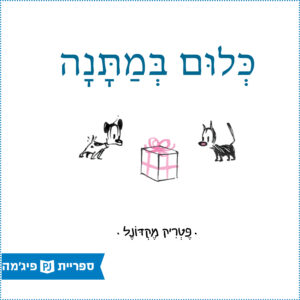 The Gift of Nothing
The Gift of Nothing 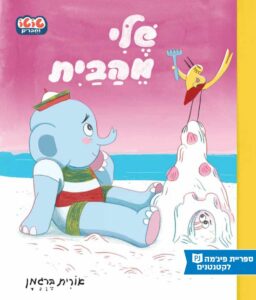 Toto & Friends: Mine!
Toto & Friends: Mine! 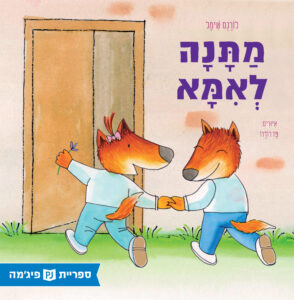 A Gift for Mama
A Gift for Mama 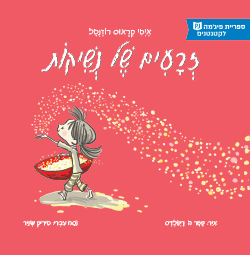 Plant a Kiss
Plant a Kiss 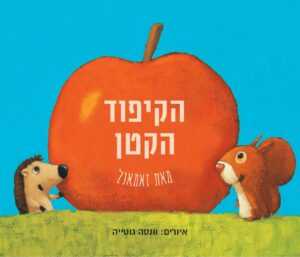 Little Hedgehog
Little Hedgehog 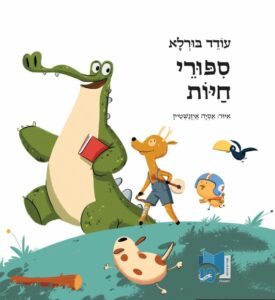 Animal Stories
Animal Stories 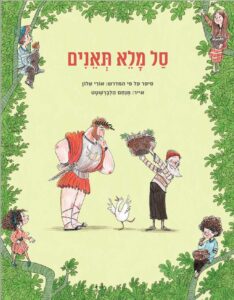 A Basket Full of Figs
A Basket Full of Figs 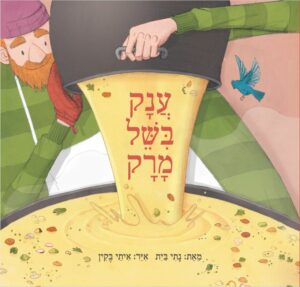 The Giant is Cooking Soup
The Giant is Cooking Soup 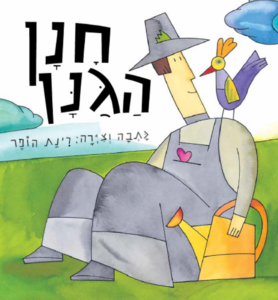 Hannan the Gardener
Hannan the Gardener 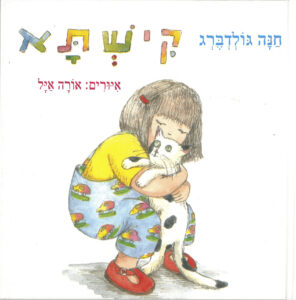 Kishta
Kishta 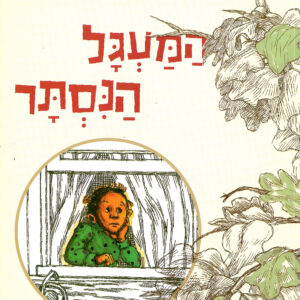 A Circle of Friends
A Circle of Friends 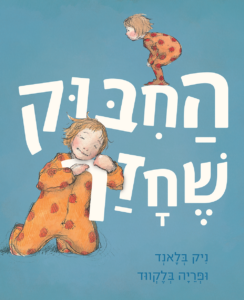 The Runaway Hug
The Runaway Hug 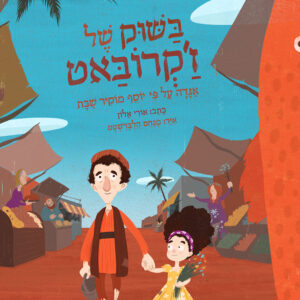 In the Market of Zhakrobat
In the Market of Zhakrobat 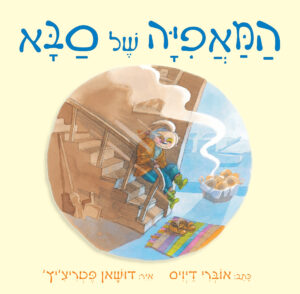 Bagels From Benny
Bagels From Benny 



